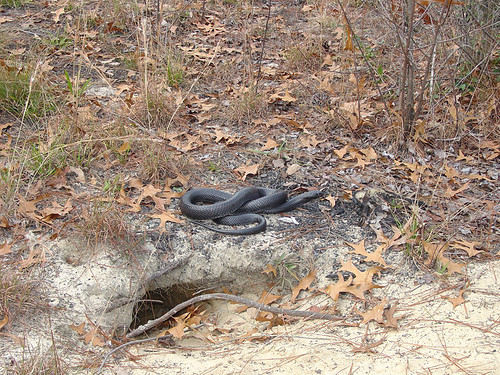
A recent sighting of a threatened snake in Georgia by partners of USDA’s Natural Resources Conservation Service (NRCS) shows how conservation work helps wildlife.
The Orianne Society and the Georgia Department of Natural Resources, two key NRCS partners, spotted an Eastern indigo snake in an area where NRCS and landowners have worked together to restore wetlands, an ecosystem where the species typically spends several months of the year.
The Eastern indigo snake is a large nonvenomous snake found in Georgia and Florida. Its historic range also included Mississippi, Alabama and South Carolina, and it’s the nation’s longest native snake. The snake was listed as threatened in 1978 because of a lack of habitat and people capturing for pets or killing them.
In Georgia, the Eastern indigo snake spends December through April in upland areas with sandy soils, called the sandhills. From May to July, the snakes move to summer territories, such as shady creek bottoms.
In southern Georgia, landowners have enrolled about 35,000 acres into the former Wetlands Reserve Program, a conservation easement program that enables farmers, ranchers and forest landowners to restore and protect wetlands. The 2014 Farm Bill merged this program with two other easement programs, forming the Agricultural Conservation Easements Program.
By keeping the land in its natural use, the landowner receives a one-time or multi-year easement payment, depending on their preference. About 40 percent of those easements have landscape features of the sandhills.
These snakes, along with many of their counterparts, need a mix of wetland and upland habitat to survive through the different seasons.
The upland buffers of conservation easements, such as the sandhills in the area where the snake was spotted, provides great wildlife habitat while leading to other environmental benefits, including cleaner water and air and healthier soil.
These snakes are often found near, in and around the burrows of gopher tortoises, another denizen of Southern lands with sandy soils and another at-risk species. The Eastern indigo snake feasts on a variety of small birds, small mammals, snakes, turtles, lizards, frogs, toads and eggs.
The snake’s spotting shows how important this program is to a variety of wildlife species, including this federally threatened snake. Through restoration of wetlands, NRCS hopes to increase numbers of this unique Southern snake.
Learn more about conservation easements.


